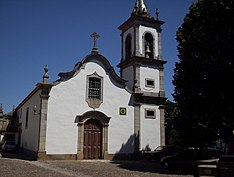Cathedral of Pinhel
| Church of São Luís (Igreja de São Luís) | |
| Parochial Church of Pinhel, Monastery of São Luís de Pinhel | |
| Church (Igreja) | |
|
A view of the front facade of the Church of São Luís in the Praça Sacadura Cabral
|
|
| Official name: Mosteiro de São Luís de Pinhel/Igreja Matriz de Pinhel/Igreja de São Luís | |
| Named for: Pinhel | |
| Country | |
|---|---|
| Region | Centro |
| Subregion | Beira Interior Sul |
| District | Guarda |
| Municipality | Pinhel |
| Location | Pinhel |
| - coordinates | 40°46′30.8″N 7°3′44.8″W / 40.775222°N 7.062444°WCoordinates: 40°46′30.8″N 7°3′44.8″W / 40.775222°N 7.062444°W |
| Architects | Oficina Fernandes |
| Style | Baroque |
| Materials | Granite, Masonry, Plaster, Tile |
| Origin | 1596 |
| Owner | Portuguese Republic |
| For public | Public |
| Easiest access | Praça Sacadura Cabral |
| Management | Instituto Gestão do Patrimonio Arquitectónico e Arqueológico |
| Operator | Roman Catholic Diocese of Guarda |
| Status |
Monument of Public Interest Monumento de Interesse Público |
| Listing | Dispatch 740-CX/2012, Diário da República, Série 2, 248 (24 December 2012) |
The Church of São Luís (Portuguese: Igreja de São Luís) is a Latin Catholic Baroque church and former cathedral in the civil parish of Pinhel, in the municipality of the same name, Portuguese district of Guarda.
The church and monastery of São Luís was founded in 1596, for the Poor Clares sisters by Luís de Figueiredo Falcão. At its founding, it was stipulated that he and his descendants should be buried in the monastery and that the family's coat-of-arms should be inscribed into the walls of the structure. Also, his sister, who was abbess would remain in that position for life, moving from the Convent of Santa Clara in Guarda to take-up her residence, along with 33 other clerics (ten of which were selected by the new abbess) and a stipend of 20$000 réis. It was further stipulated that the convent would be closed to the public and only visited by close family members. The monastery would have an annual rent of 100$000 and 16 moios of bread allocated to the religious sisters.
On 5 December 1602, the convent was transferred to the Order of St. Francis, creating a quarrel between the founder and various prelates, who wanted to expand the monastery. Only in October of the following year the first nuns began to enter the institution. Successive conflicts with the bishop over the status of the sisters, that resulted in the interdiction of the monastery.
In the 17th century, the box-ceiling and retable altar was finally installed in the church, along with azulejo tiles in the presbytery. Religious reliquaries were gifted by Pope Paul V in 1620, consisting of artifacts associated with São Caio Papa, São Vital, Santa Teodora and Santa Cristina.
Its founder, Luís Falcão, was buried onsite in 1631. Within another 15 years his son, António de Figueirdo Falcão would also be buried.
...
Wikipedia

